Predator-Prey Relationship
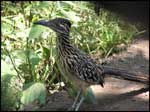
Whether it is a roadrunner swallowing a lizard, a blue crab eating a fish, an American Egret catching a perch, a shark investigating a surface disturbance that could be a meal, or a man rounding up a cow for slaughter, the predator kills to provide food for itself or its family.
In Nature's plan, there is no such thing as a good or bad animal. There are only those animals that kill to eat (predators) and those that are killed and eaten (prey). It is unfair for us to judge their natural survival actions by our own ideas of what is good and bad or to decide that all predators are villains.
When the coyote chases, catches, kills, and eats the cute, furry rabbit, it is not being intentionally cruel. It is only meeting its physical need for food with whatever is available at the time. Its meal could just as easily have been a mouse, rat, or other small creature if one of these other animals had been closer or easier to catch.
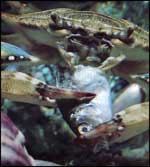
Is there really any difference between a hungry mountain lion stalking, killing, and eating a deer and a hunter stalking, shooting, and taking a deer home for his family to eat? Both the mountain lion and the human hunter are predators, using the deer for food. You may think that since you are not a hunter, you are not a predator. How about the beef, pork, lamb, fish, or chicken you eat each day? Just because you do not kill the animal yourself does not make you less of a predator. You are still an animal eating the flesh of another animal to satisfy your hunger.
People usually think of predators as meat-eating mammals (carnivores), but the bird, reptile, amphibian, fish, and insect families also have their predators. Eagles, hawks, falcons, and owls are probably the best-known predators of the bird world. Everyone knows how one of them can swoop down, catch and kill a small creature, and then use a sharp-edged, hooked beak to tear bite-sized pieces of flesh from the animal. Because they feed on small mammals, are these birds more cruel than the fish-eating pelicans, gulls, terns, herons, egrets, and kingfishers or the insect-eating woodpeckers, flycatchers, warblers, swallows, swifts, and chickadees? Although their food preferences are different, they are all predatory birds killing to satisfy their hunger.
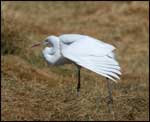
You probably won't have any problem recognizing the alligator member of the reptile family as a predator because it eats anything it can catch, either in the water or on land. Snakes also are known for catching and swallowing a variety of creatures, but how many of you stopped to realize that a lizard that eats insects is also a predator? A couple of other quick-tongued predators, the frog and the toad, belong to the amphibian family. Would you put the lizard, frog, and toad in the same category with the alligator? You should. All are predators, killing and eating in order to survive.
Sharks are probably the most feared predators of the sea, but are their eating habits, although vicious, any more predatory than those of the freshwater bass? From the time it is large enough to eat some of its own brothers and sisters to the time it can swallow a frog or baby duck swimming on the water's surface, the black bass spends its time searching its watery world for things to eat. If it weren't for its predatory habits, we wouldn't be able to catch the bass with all the different kinds of baits and lures we use. That fish-shaped lure looks like a real fish and that plastic worm looks like a real worm or small snake to the hungry bass.
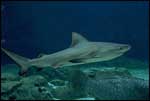
Although many insects feed on each other, the one you are probably the most familiar with is the spider. It sits in its web and patiently waits for an insect to get caught in its sticky trap. When this happens, the spider rushes out, kills or paralyzes the insect, wraps it in silk, and then sucks out its body liquids.
You may be thinking at this point that the predator has the best life, with nothing to worry about except catching its next meal. But did you know that many animals are both predators and prey?
When a spider is sitting in its web waiting for its insect meal, it is the predator. However, if a lizard's tongue darts out and catches the spider, the spider becomes the lizar's prey. The predatory lizard may then be swallowed by a roadrunner, which may later be caught and eaten by a coyote. The wandering coyote may fall victim to the greatest predator of all, man.
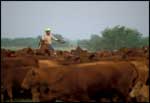
Predation, the eating of one animal by another, is one of the ways nature keeps animal populations under control. Great swarms of insects would soon cover the earth, creating a threat to all living things, if it weren't for the spiders, frogs, fish, lizards, snakes, birds, and mammals that eat them. Plant-eating animals, such as mice, rats, and rabbits, would soon strip the land bare without the controlling effect of predators. Areas where large predators have been reduced through trapping, shooting, and other predator-control methods often develop large populations of mice, rats, and rabbits that can destroy the plants needed by other wildlife species for both food and shelter. If the predators had been allowed to remain, the prey species probably would have been kept under control.
Predation also assures the "survival of the fittest," nature's basic law. Old, diseased, or injured animals are easy meals for predators. Young animals are also in danger since they are not as strong, fast, or wise as adult animals. Those with strong instincts for survival will learn how to avoid their predators. Natural predation has a definite place in the balance of nature, so the next time you catch yourself thinking how bad a predator is for killing a cute little bunny, remember the predator is only killing for food.
Ilo
Hiller
1983 Predator-Prey Relationship.
Young
Naturalist. The
Louise Lindsey Merrick
Texas Environment Series,
No. 6, pp. 59-62. Texas
A&M University Press,
College Station.